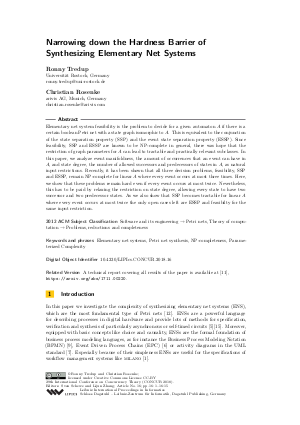Narrowing down the Hardness Barrier of Synthesizing Elementary Net Systems
Authors Ronny Tredup, Christian Rosenke
-
Part of:
Volume:
29th International Conference on Concurrency Theory (CONCUR 2018)
Part of: Series: Leibniz International Proceedings in Informatics (LIPIcs)
Part of: Conference: International Conference on Concurrency Theory (CONCUR) - License:
 Creative Commons Attribution 3.0 Unported license
Creative Commons Attribution 3.0 Unported license
- Publication Date: 2018-08-31
File

PDF
LIPIcs.CONCUR.2018.16.pdf
- Filesize: 490 kB
- 15 pages
Document Identifiers
Related Versions
Subject Classification
ACM Subject Classification
- Software and its engineering → Petri nets
- Theory of computation → Problems, reductions and completeness
Keywords
- Elementary net systems
- Petri net synthesis
- NP-completeness
- Parameterized Complexity
Metrics
- Access Statistics
-
Total Accesses (updated on a weekly basis)
0PDF Downloads0Metadata Views
Abstract
Elementary net system feasibility is the problem to decide for a given automaton A if there is a certain boolean Petri net with a state graph isomorphic to A. This is equivalent to the conjunction of the state separation property (SSP) and the event state separation property (ESSP). Since feasibility, SSP and ESSP are known to be NP-complete in general, there was hope that the restriction of graph parameters for A can lead to tractable and practically relevant subclasses. In this paper, we analyze event manifoldness, the amount of occurrences that an event can have in A, and state degree, the number of allowed successors and predecessors of states in A, as natural input restrictions. Recently, it has been shown that all three decision problems, feasibility, SSP and ESSP, remain NP-complete for linear A where every event occurs at most three times. Here, we show that these problems remain hard even if every event occurs at most twice. Nevertheless, this has to be paid by relaxing the restriction on state degree, allowing every state to have two successor and two predecessor states. As we also show that SSP becomes tractable for linear A where every event occurs at most twice the only open cases left are ESSP and feasibilty for the same input restriction.
Cite As Get BibTex
Ronny Tredup and Christian Rosenke. Narrowing down the Hardness Barrier of Synthesizing Elementary Net Systems. In 29th International Conference on Concurrency Theory (CONCUR 2018). Leibniz International Proceedings in Informatics (LIPIcs), Volume 118, pp. 16:1-16:15, Schloss Dagstuhl – Leibniz-Zentrum für Informatik (2018)
https://doi.org/10.4230/LIPIcs.CONCUR.2018.16
BibTex
@InProceedings{tredup_et_al:LIPIcs.CONCUR.2018.16,
author = {Tredup, Ronny and Rosenke, Christian},
title = {{Narrowing down the Hardness Barrier of Synthesizing Elementary Net Systems}},
booktitle = {29th International Conference on Concurrency Theory (CONCUR 2018)},
pages = {16:1--16:15},
series = {Leibniz International Proceedings in Informatics (LIPIcs)},
ISBN = {978-3-95977-087-3},
ISSN = {1868-8969},
year = {2018},
volume = {118},
editor = {Schewe, Sven and Zhang, Lijun},
publisher = {Schloss Dagstuhl -- Leibniz-Zentrum f{\"u}r Informatik},
address = {Dagstuhl, Germany},
URL = {https://drops.dagstuhl.de/entities/document/10.4230/LIPIcs.CONCUR.2018.16},
URN = {urn:nbn:de:0030-drops-95546},
doi = {10.4230/LIPIcs.CONCUR.2018.16},
annote = {Keywords: Elementary net systems, Petri net synthesis, NP-completeness, Parameterized Complexity}
}
Author Details
References
- Alessandra Agostini and Giorgio De Michelis. Improving flexibility of workflow management systems. In Wil M. P. van der Aalst, Jörg Desel, and Andreas Oberweis, editors, Business Process Management, Models, Techniques, and Empirical Studies, volume 1806 of Lecture Notes in Computer Science, pages 218-234. Springer, 2000. URL: http://dx.doi.org/10.1007/3-540-45594-9_14.
- Eric Badouel, Luca Bernardinello, and Philippe Darondeau. The synthesis problem for elementary net systems is np-complete. Theor. Comput. Sci., 186(1-2):107-134, 1997. URL: http://dx.doi.org/10.1016/S0304-3975(96)00219-8.
- Eric Badouel, Luca Bernardinello, and Philippe Darondeau. Petri Net Synthesis. Texts in Theoretical Computer Science. An EATCS Series. Springer, 2015. URL: http://dx.doi.org/10.1007/978-3-662-47967-4.
-
Jordi Cortadella. Private correspondance, 2017.

- Jordi Cortadella, Michael Kishinevsky, Alex Kondratyev, Luciano Lavagno, and Alex Yakovlev. Complete state encoding based on the theory of regions. In 2nd International Symposium on Advanced Research in Asynchronous Circuits and Systems (ASYNC '96), March 18-21, 1996, Aizu-Wakamatsu, Fukushima, Japan, pages 36-47. IEEE Computer Society, 1996. URL: http://ieeexplore.ieee.org/xpl/mostRecentIssue.jsp?punumber=3564, URL: http://dx.doi.org/10.1109/ASYNC.1996.494436.
-
August-Wilhelm Scheer. Business Process Engineering. Reference Models for Industrial Enterprises. Springer, 1994.

-
UML. Unified Modeling Language (UML). Object Management Group, 2018.

- Kunihiko Hiraishi. Some complexity results on transition systems and elementary net systems. Theor. Comput. Sci., 135(2):361-376, 1994. URL: http://dx.doi.org/10.1016/0304-3975(94)90112-0.
-
OMG. Business Process Model and Notation (BPMN). Object Management Group, 2018.

- Cristopher Moore and J. M. Robson. Hard tiling problems with simple tiles. Discrete & Computational Geometry, 26(4):573-590, 2001. URL: http://dx.doi.org/10.1007/s00454-001-0047-6.
- Christian Rosenke and Ronny Tredup. The hardness of synthesizing elementary net systems from highly restricted inputs. CoRR, abs/1711.00220, 2017. URL: http://arxiv.org/abs/1711.00220.
- Grzegorz Rozenberg and Joost Engelfriet. Elementary net systems. In Wolfgang Reisig and Grzegorz Rozenberg, editors, Lectures on Petri Nets I: Basic Models, Advances in Petri Nets, the volumes are based on the Advanced Course on Petri Nets, held in Dagstuhl, September 1996, volume 1491 of Lecture Notes in Computer Science, pages 12-121. Springer, 1996. URL: http://dx.doi.org/10.1007/3-540-65306-6_14.
- Vincent Schmitt. Flip-flop nets. In Claude Puech and Rüdiger Reischuk, editors, STACS 96, 13th Annual Symposium on Theoretical Aspects of Computer Science, Grenoble, France, February 22-24, 1996, Proceedings, volume 1046 of Lecture Notes in Computer Science, pages 517-528. Springer, 1996. URL: http://dx.doi.org/10.1007/3-540-60922-9_42.
- Ronny Tredup, Christian Rosenke, and Karsten Wolf. Elementary net synthesis remains np-complete even for extremely simple inputs. In Victor Khomenko and Olivier H. Roux, editors, Application and Theory of Petri Nets and Concurrency - 39th International Conference, PETRI NETS 2018, Bratislava, Slovakia, June 24-29, 2018, Proceedings, volume 10877 of Lecture Notes in Computer Science, pages 40-59. Springer, 2018. URL: http://dx.doi.org/10.1007/978-3-319-91268-4_3.
- Alex Yakovlev and Albert Koelmans. Petri Nets and Digital Hardware Design. In Wolfgang Reisig and Grzegorz Rozenberg, editors, Lectures on Petri Nets II: Applications, volume 1492 of Lecture Notes in Computer Science, pages 154-236. Springer, 1998. URL: http://dx.doi.org/10.1007/3-540-65307-4.
